Tobacco Mosaic Virus Uses In Pharmaceutical Research: Difference between revisions
Itschnerms (talk | contribs) No edit summary |
Itschnerms (talk | contribs) No edit summary |
||
| Line 29: | Line 29: | ||
==Discovery== | ==Discovery== | ||
The discovery of the Tobacco Mosaic Virus (TMV) and the mosaic disease it caused can be attributed to three individuals, Adolf Mayer, Dmitrii Iwanowski, and Martinus Beijerinck. In 1886 Adolf Mayer (1843-1942) found in his research that extracts from ground up diseased tobacco plants could infect healthy tobacco plants. He followed Koch’s postulates moving forward in his research and was able to produce cultured organisms from the extracts but would not be able to reproduce the disease. Using filter paper to sort out the microbe causing this disease, Mayer concluded that a bacterial species was responsible [1]. He reasoned that the infecting agent passed through the initial filtration paper and continued to be infections, but was filtered out after multiple filtrations and cease infecting other plants. Replicated research on the filtration of the microbe causing the tobacco mosaic disease by Dmitrii Iwanowski (1864-1920) found contrasting results to Mayer [1]. In 1892 Iwanowski reported that the Chamberland filter candles, which were fine filer that retained bacteria, did not trap the disease-causing microbe, it passed through the filter. This led Iwanowski to believe that a toxin released from a bacterium, which was dissolved in sap, caused the disease or the bacterium was small enough to pass through the filter candles [1]. Martinus Beijerinck (1851-1931) also worked with filtration experiments and also found that the material, absent of microorganisms, that passed through the porcelain filters continued to be infectious to healthy plants. In 1898 Beijerinck called this material a virus and continued to research its transmission and growth. Although these three individuals were not completely correct in their assumptions about the TMV, their discoveries were crucial to its classification in the microbial world. [1]<br> | The discovery of the Tobacco Mosaic Virus (TMV) and the mosaic disease it caused can be attributed to three individuals, Adolf Mayer, Dmitrii Iwanowski, and Martinus Beijerinck. In 1886 Adolf Mayer (1843-1942) found in his research that extracts from ground up diseased tobacco plants could infect healthy tobacco plants. He followed Koch’s postulates moving forward in his research and was able to produce cultured organisms from the extracts but would not be able to reproduce the disease. Using filter paper to sort out the microbe causing this disease, Mayer concluded that a bacterial species was responsible [1]. He reasoned that the infecting agent passed through the initial filtration paper and continued to be infections, but was filtered out after multiple filtrations and cease infecting other plants. Replicated research on the filtration of the microbe causing the tobacco mosaic disease by Dmitrii Iwanowski (1864-1920) found contrasting results to Mayer (<b>Figure 2</b>)[[#References|[1]]].. In 1892 Iwanowski reported that the Chamberland filter candles, which were fine filer that retained bacteria, did not trap the disease-causing microbe, it passed through the filter. This led Iwanowski to believe that a toxin released from a bacterium, which was dissolved in sap, caused the disease or the bacterium was small enough to pass through the filter candles [1]. Martinus Beijerinck (1851-1931) also worked with filtration experiments and also found that the material, absent of microorganisms, that passed through the porcelain filters continued to be infectious to healthy plants. In 1898 Beijerinck called this material a virus and continued to research its transmission and growth. Although these three individuals were not completely correct in their assumptions about the TMV, their discoveries were crucial to its classification in the microbial world. [1]<br> | ||
<br> | <br> | ||
<ref>[https://www.apsnet.org/edcenter/intropp/lessons/viruses/Pages/TobaccoMosaic.aspx<i>Tobacco Mosaic Virus</i>]</ref> | <ref>[https://www.apsnet.org/edcenter/intropp/lessons/viruses/Pages/TobaccoMosaic.aspx<i>Tobacco Mosaic Virus</i>]</ref> | ||
Revision as of 15:33, 26 April 2018
Tobacco Mosaic Virus Uses in Pharmaceutical Research
Section
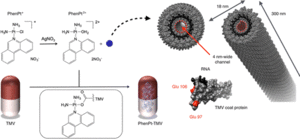
By Michael Itschner II
At right is a sample image insertion. It works for any image uploaded anywhere to MicrobeWiki.
The insertion code consists of:
Double brackets: [[
Filename: PHIL_1181_lores.jpg
Thumbnail status: |thumb|
Pixel size: |300px|
Placement on page: |right|
Legend/credit: Electron micrograph of the Ebola Zaire virus. This was the first photo ever taken of the virus, on 10/13/1976. By Dr. F.A. Murphy, now at U.C. Davis, then at the CDC.
Closed double brackets: ]]
Other examples:
Bold
Italic
Subscript: H2O
Superscript: Fe3+
Introduce the topic of your paper. What is your research question? What experiments have addressed your question? Applications for medicine and/or environment?
Sample citations:
A citation code consists of a hyperlinked reference within "ref" begin and end codes.
Introduction
The Tobacco Mosaic Virus (TMV) has been well researched since it has been defined a virus in 1898 by Martinus Beijerinck. TMV has been used as a model virus for a teaching tool in biology classes and as a scaffold for drug delivery mechanisms. Since there has been much research done on this virus previously, TMV has a widely accepted and well-defined structure. The scaffolding of this virus is of particular interest because its protein base serves as a template for precise targeting of surface groups on cells. Plant viruses have drawn more attention since they are unable to infect mammalian hosts and have good blood and tissue compatibility in mammals. TMV is also to biodegradable and able to be cleaned out of non-target tissues and organs, making TMV a probable candidate for the targeting and delivery of therapeutics to mammals. [1]
Every point of information REQUIRES CITATION using the citation tool shown above.
Discovery
The discovery of the Tobacco Mosaic Virus (TMV) and the mosaic disease it caused can be attributed to three individuals, Adolf Mayer, Dmitrii Iwanowski, and Martinus Beijerinck. In 1886 Adolf Mayer (1843-1942) found in his research that extracts from ground up diseased tobacco plants could infect healthy tobacco plants. He followed Koch’s postulates moving forward in his research and was able to produce cultured organisms from the extracts but would not be able to reproduce the disease. Using filter paper to sort out the microbe causing this disease, Mayer concluded that a bacterial species was responsible [1]. He reasoned that the infecting agent passed through the initial filtration paper and continued to be infections, but was filtered out after multiple filtrations and cease infecting other plants. Replicated research on the filtration of the microbe causing the tobacco mosaic disease by Dmitrii Iwanowski (1864-1920) found contrasting results to Mayer (Figure 2)[1].. In 1892 Iwanowski reported that the Chamberland filter candles, which were fine filer that retained bacteria, did not trap the disease-causing microbe, it passed through the filter. This led Iwanowski to believe that a toxin released from a bacterium, which was dissolved in sap, caused the disease or the bacterium was small enough to pass through the filter candles [1]. Martinus Beijerinck (1851-1931) also worked with filtration experiments and also found that the material, absent of microorganisms, that passed through the porcelain filters continued to be infectious to healthy plants. In 1898 Beijerinck called this material a virus and continued to research its transmission and growth. Although these three individuals were not completely correct in their assumptions about the TMV, their discoveries were crucial to its classification in the microbial world. [1]
[2]
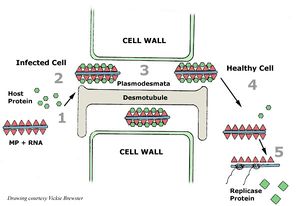
Structure
Include some current research, with at least one figure showing data.
[3]
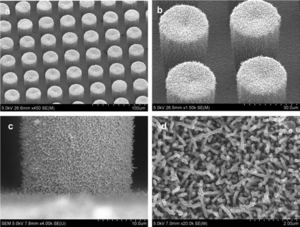
Transmission
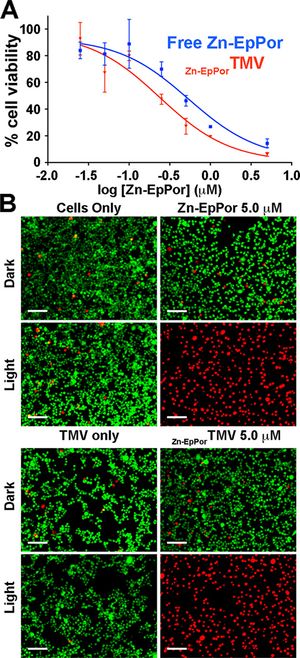
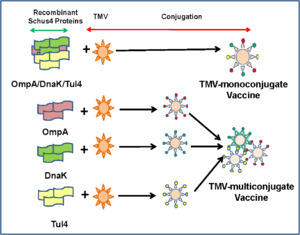
Epidemiology
Using TMV in Drug Delivery
TMV as a Treatment for Melanoma
Tobacco Mosaic Virus (TMV) as a Vaccine
TMV Scaffolds Used to Make Other Nanoparticles
TMV Applications in Micromachines
Conclusions
References
- ↑ Tobacco Mosaic Virus Delivery of Phenanthriplatin for Cancer therapy
- ↑ Tobacco Mosaic Virus
- ↑ Hierarchical Three-Dimensional Microbattery Electrodes Combining Bottom-Up Self-Assembly and Top-Down Micromachining
- ↑ High Aspect Ratio Nanotubes Formed by Tobacco Mosaic Virus for Delivery of Photodynamic Agents Targeting Melanoma
- ↑ Development of a Multivalent Subunit Vaccine against Tularemia Using Tobacco Mosaic Virus (TMV) Based Delivery System
Authored for BIOL 238 Microbiology, taught by Joan Slonczewski, 2018, Kenyon College.
